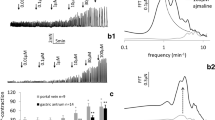Summary
-
1.
The contractile effect of 5-HT in the isolated longitudinal ileal muscle of adult guinea-pigs was studied over a large concentration range.
-
2.
5-HT produced a biphasic concentration-response curve indicative of an interaction with at least two indenpendent populations of receptors. The concentrations which elicited half-maximal effects for the first and the second phases of the concentration-response curve were estimated as 1.5±1.2×10−8 mol/l and 1.3±0.4×10−6 mol/l respectively. The maximal response produced by the interaction of 5-HT with the high affinity receptor (i. e. first phase) was calculated as 27±9.3% of the total response.
-
3.
The biphasic concentration-response was not influenced by methysergide (10−6 mol/l).
-
4.
The effect of low concentrations of 5-HT (<3×10−7 mol/l) was antagonised by atropine (10−7 mol/l), tetrodotoxin (TTX) (10−6 mol/l), morphine (10−5 mol/l), the substance P antagonist,d-Pro4,d-Trp7,9-SP4–11 (3×10−5 mol/l) and capsaicin (10−5 mol/l). Physostigmine (10−7 mol/l) augmented the effect.
-
5.
The response to high concentrations of 5-HT (3×10−7–3×10−6 mol/l) was antagonised by ICS 205-930 andd-Pro4,d-Trp7,9-SP4–11 in a competitive manner and was inhibited by TTX, morphine and capsaicin in an insurmountable way.
-
6.
The effect of very high concentrations of 5-HT (>10−5 mol/l) could be partially antagonised by methysergide (10−7 mol/l) in the presence of ICS 205-930 (10−7 mol/l) and totally by a combination of methysergide and TTX.
-
7.
We conclude that in longitudinal muscle strips from the ileum of adult guinea-pigs a contractile action of 5-HT can be mediated by the activation of three independent receptors. At concentrations below 3×10−7 mol/l 5-HT causes the release of substance P which subsequently releases acetylcholine. At concentrations higher than 3×10−7 mol/l 5-HT releases substance P which then directly activates SP-receptors on the smooth muscle cells. The stimulation of postjunctional 5-HT D-receptors only occurs at concentrations of 5-HT greater than 10−5 mol/l, and thus appears to be of minor importance.
Similar content being viewed by others
References
Adam-Vizi V, Vizi ES (1978) Direct evidence of acetylcholine releasing effect of serotonin in the Auerbach plexus. J Neural Transm 42:127–138
Arunlakshana O, Schild HO (1959) Some quantitative uses of drug antagonists. Br J Pharmacol Chemother 14:48–58
Baron SA, Jaffe BM, Gintzler AR (1983) Release of substance P from the enteric nervous system: direct quantitation and characterization. J Pharmacol Exp Ther 227:365–368
Bartho L, Holzer P, Donnerer J, Lembeck F (1982) Evidence for the involvement of substance P in the atropine-resistant peristalsis of the guinea-pig ileum. Neurosci Lett 32:69–74
Berman M, Weiss MF (1967) SAAM Manual NIH, PHS Publication 1703, Bethesda, Maryland, USA
Brownlee G, Johnson ES (1963) The site of 5-hydroxytryptamine receptor on the intramural nervous plexus of the guinea-pig isolated ileum. Br J Pharmacol 21:306–322
Caranikas S, Mizrahi I, D'Orleans-Juste P, Regoli D (1982) Antagonists of substance P. Eur J Pharmacol 77:205–206
Chahl LA (1982) Evidence that the contractile response of the guinea-pig ileum to capsaicin is due to substance P release. Naunyn-Schmiedeberg's Arch Pharmacol 319:212–215
Chahl LA (1983) Substance P mediates atropine-sensitive response of guinea-pig ileum to serotonin. Eur J Pharmacol 87:485–489
Day M, Vane JR (1963) An analysis of the direct and indirect actions of drugs on the isolated guinea-pig ileum. Br J Pharmacol 20:150–170
Donatsch P, Engel G, Richardson BP, Stadler PA (1984) ICS 205-930: a highly selective and potent antagonist at peripheral neuronal 5-hydroxytryptamine receptors. Br J Pharmacol 81:34P-35P
Engel G, Hoyer D, Berthold R, Wagner H (1981) (±)[125Iodo]-cyanopindolol, a new ligand for beta-adrenoceptors in guinea-pig. Naunyn-Schmiedeberg's Arch Pharmacol 317:277–285
Fozard JR, Mobarok Ali ATM (1978) Receptors for 5-hydroxytryptamine on the sympathetic nerves of the rabbit heart. Naunyn-Schmiedeberg's Arch Pharmacol 301:223–235
Gaddum JH, Picarelli ZP (1957) Two kinds of tryptamine receptor. Br J Pharmacol 12:323–328
Holzer P, Lembeck F (1980) Neurally mediated contraction of ileal longitudinal muscle by substance P. Neurosci Lett 17:101–105
Holzer P, Gamse R, Lembeck F (1980) Distribution of substance P in the rat gastrointestinal tract — lack of effect of capsaicin pretreatment. Eur J Pharmacol 61:303–307
Kilbinger H, Kruel R, Pfeuffer-Friederich I, Wessler I (1982) The effects of metoclopramide on acetylcholine release and on smooth muscle response in the isolated guinea-pig ileum. Naunyn-Schmiedeberg's Arch Pharmacol 319:231–238
MacKay D (1978) How should values of pA2 and affinity constants for pharmacological competitive antagonists be estimated? J Pharm Pharmacol 30:312–313
Mizrahi J, Escher E, Caranikas S, D'Orleans-Juste P, Regoli D (1982) Substance P antagonists active in vitro and in vivo. Eur J Pharmacol 82:101–105
Schaumann W (1957) Inhibition by morphine of the release of acetylcholine from the intestine of the guinea-pig. Br J Pharmacol 12:115–118
Snedecor GW, Cochran WG (1973) Curvilinear regression. In: Snedecor GW, Cochran WG (eds) Statistic methods, chapt 15, 6th edn. The Iowa State University Press, Ames, Iowa, USA, pp 447–471
Yau WM, Youther ML (1982) Direct evidence for a release of acetylcholine from the myenteric plexus of guinea-pig small intestine by substance P. Eur J Pharmacol 81:665–668
Author information
Authors and Affiliations
Rights and permissions
About this article
Cite this article
Buchheit, KH., Engel, G., Mutschler, E. et al. Study of the contractile effect of 5-hydroxytryptamine (5-HT) in the isolated longitudinal muscle strip from guinea-pig ileum. Naunyn-Schmiedeberg's Arch. Pharmacol. 329, 36–41 (1985). https://doi.org/10.1007/BF00695189
Received:
Accepted:
Issue Date:
DOI: https://doi.org/10.1007/BF00695189




